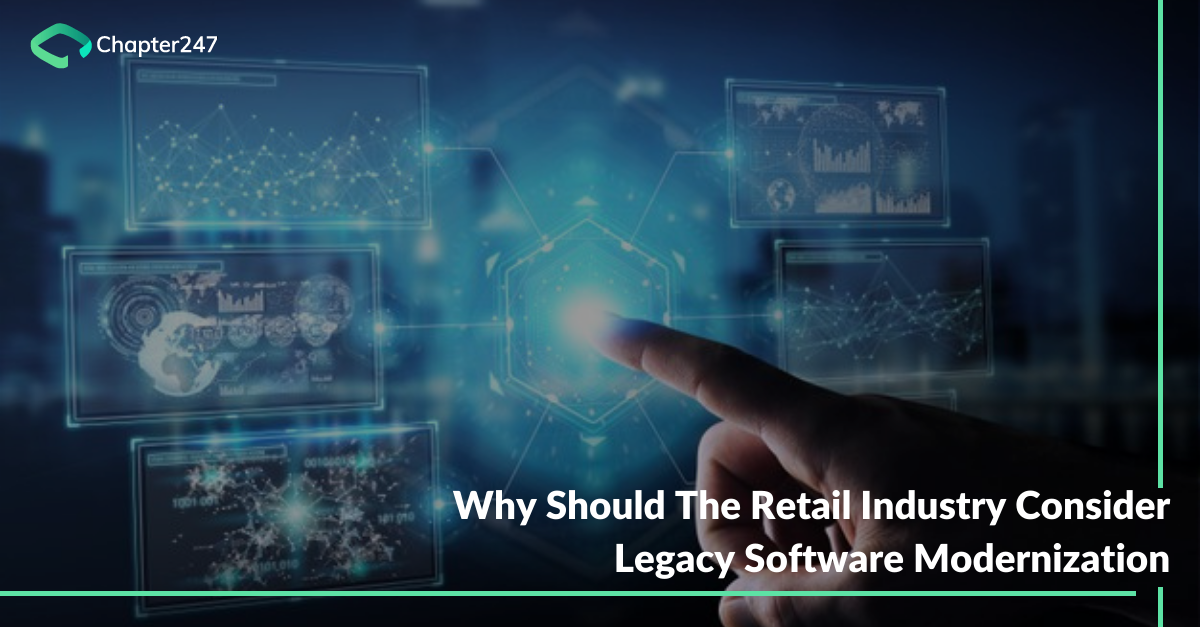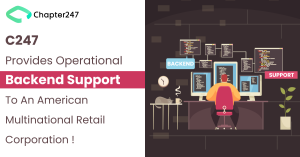Retailers are finding new ways to cope up with the new challenges that the pandemic has thrown at them. With many countries still overcoming the lockdown effect, due to the coronavirus pandemic, we believe it is the right time to rev up your game by first understanding what went wrong, and next by refurbishing new strategies to face the challenges with the same competitiveness which you did pre-pandemic time.
This blog will give you insights on why it is beneficial to transform your legacy software into a modern retail application that can go a long way in helping you revive your retail concern. The legacy transformation combines the strength of your old retail business application with modern-day technologies and software architectures to build a platform so robust that it will help you take on the challenges. According to research, the modernized legacy software also successfully reduces the overall cost of business operations by more than 13%. Not just that, businesses with modern legacy systems could also enhance their annual revenue by at least 14% which is truly substantial.
Take a look at the data
IMRG has reported that UK online retail sales rose by 22% in the first week of April compared to the same time last year. While this figure suggests a promising picture for the retail world, it is likely that the rise has been due to a rise in a select few categories. The beauty sector for instance saw a 140% meteoric rise in the first week of April while electricals rose 90%. In contrast, clothing saw online sales dip by 20%.
As of April 2020, the U.S. eCommerce year-over-year growth was up by 68% surpassing 40% of the total retail sales. Consumers have now increased their spending on hygiene and sustainable products and more than 50% of consumers report spending more on convenience to buy what they need with ease which is contactless shopping, on-demand fulfillment, and much more. There has also been a surge in mobile payment usage, delivery app downloads, and buy-online-pick-up-in-store (BOPIS) concept adoption. Many have adopted this because of the lack of other options, while many others perceive these options to be safer and healthier.
Despite these encouraging prospects, overall retail sales globally can either go down the lane or could become stagnant for a while. The illustration below highlights E-marketer’s analysis of what retail sales would be four years from now. It shows that worldwide retail sales will decline by 5.7% due to the pandemic.

Why legacy software modernization has become a must for the retail industry
Insights from the CBinsights report have reported that 40 bankruptcies had been declared in retail from 2015 till March 2018. The biggest challenge is the declining traditional physical retail scenario because of the marked shift to digital commerce and with the pandemic fewer customers are shopping in traditional ways. Retailers who are digital stragglers are losing ground to bigger players and those who do not adapt to it quickly are likely to find it very difficult to compete.
As the winds of change indicate towards retail digitalization and software upgradation, retailers have to modernize their software and their ways of working purely to optimize their operations and offer strategically differentiated end-to-end customer experiences at faster speeds which will drive growth and increase retention.
- No matter how old your software is, it has to be integrated well with other tools and applications that are used to run your retail chapter. For instance, if you are planning to implement a new CRM or adding a live chat functionality in your retail website, these updates you have to match with a system that is capable of handling integrations. If as a forward-looking business you are not able to do this as you are a digital laggard, and you are hog-tied to an old legacy system, expect that customers will switch over to your competitor.
- Legacy systems especially in the retail sector are not safe because of vast customer data available on the interface. In such cases, legacy systems lack updates, patches, and functionalities that adhere to newer software standards.
- With older versions of the software comes the triggers of slow operational speed over time, having multiple glitches and takes a lot of time to perform standard tasks and reasons good enough for you to consider legacy systems. In order to improve the performance and efficiency of your outdated system, it is important that you contact a software development company like ours to improve the process of software quality management and testing.
- The older the software application is, the harder it becomes to support it, more so when a third-party vendor is working along with you. This becomes even more problematic when no one from your in-house department has a fair and comprehensive understanding of the way it works.
- To meet the growing needs of your customers, considering the retail industry is dynamic, your software should first meet the modern demands. If you are not scalable and flexible then will affect your brand image resulting in poor site traffic and poor revenue.
- Many retail organizations do not go for legacy software upgradation because they believe it will shoot up their budget and costs will be difficult to cover. But in reality, the opposite is true because your obsolete application will take up more of your budget if you continue using it compared to legacy software modernization. The spending is mostly on the maintenance of legacy systems that may result in inefficiency, security gaps, and other risks. And that is just the tip of the iceberg as estimation is possible only after understanding the present application.
Benefits of software upgradation to retail organizations
1.Rapid concept to customer
As a software development company for many years, we have seen many retailers struggle with their legacy IT systems due to the lack of modern systems commanding their business. This has created barriers to agility, speed, and quality compromising business existence. Hence, it is recommended that such a complex journey be sufficiently strategized and phased. With better systems of software at your disposal, you will be faster to reach out to customers with your ideas and products.
2.Shift to an innovation-driven culture
Shifts from the legacy system also indicate that the retail organization will now be more prepared to drive innovation in the organization. Legacy implementation is not just about using advanced technology but also mapping innovation. By modernizing your legacy software you will understand that innovation has to be in the context of solving real-world problems which can help you become the differentiator.
3.Innovation-driven culture
The meaning of ‘innovation’ may vary from person to person. But certain things remain standard: an adroit leadership, a risk-taking culture, a tech-driven workforce – always mapping innovation to business value rather than implementing cool technology. Innovation needs to be in the context of solving real-world problems at scale for it to be a differentiator.
4.More responsiveness
As more and more burden is placed on digital systems to support customer needs and critical business operations, legacy systems could be causing roadblocks in fastening the responsiveness of the application. The fact that you have decided to go for legacy modernization, your systems are going to be more flexible and responsive resulting in happier customers all along the customer buying process. Your retail business becomes more agile than ever, and you can better respond not just to your customers but also to your vendors.
5.Better compliance and customer support
If you are not complying with the regulations of the industry, be prepared to shell out millions to compensate. But when you adhere to software compliances, you can easily get an edge over your competition as it will only accelerate your offering and increase the trust factor. Modernized systems also make it easier to update logs and reports from anywhere at any time. With real-time data more at your disposal, tracking the needs of the customer is far easier than it was with legacy systems.
6.Better security
Security is a big reason to consider modernizing legacy systems. Outdated systems make them highly vulnerable to malware attacks and data breaches. Lack of support from vendors aggravates the vulnerability. You can’t seem to rely on systems that seemed secure 5 years ago. Modernization of legacy systems provides better security and protection to critical business operations like inventory management and customer support.
7.Better inventory management
Consumers can buy your products from a variety of channels. They have the option to purchase from brick-and-mortar stores, online shopping, buy-online-pick-up-in-store, and mobile platforms. If your business is diversified enough to have your products being purchased and distributed through multiple channels, you’re already doing great. However, when these channels are managed in silos things can get complicated. If your online inventory stocks don’t communicate with your brick-and-mortar inventory stock, then fulfilling orders can get tricky.
Look to use a modernized online inventory management software that will integrate your channel and bring everything under one head. When your superior inventory management system software communicates with multiple eCommerce platforms, operations become more streamlined. Logistics and order processes become simpler and there is general transparency throughout the business. This helps you avoid stock-outs and make better business decisions.
8.Smarter forecasting
New tools that accompany legacy upgradations will also feed your retail business with real-time information on stores, inventories, and much more. This will give you more insights on customer purchase behavior and product patterns. The data can be further used to determine buying habits and assess the popularity of products.
Chapter247 legacy software modernization solutions
If you are still stuck in legacy systems then probably you are spending about 60% of your IT budgets to maintain it. Using our legacy software modernization solutions will help you to consolidate, visualize, and redesign legacy systems.
We modernize systems with Graphical User Interfaces (GUI), relational databases, and operating systems, utilizing different strategies thereby ensuring integrity of data and functionality of mission critical systems throughout modernizations.
We are waiting to listen from you!. Give your retail business the software makeover!








